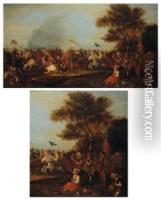Pauwels Van Hilegaert Paintings
Pauwels van Hillegaert was a Dutch painter mostly known for his works focused on history and landscapes during the Dutch Golden Age. Born in Amsterdam, the Netherlands, in 1596, he was a part of the prolific period in Dutch art history characterized by great innovation and achievement in painting.
Van Hillegaert was a leading artist of his time, and he became a member of the Amsterdam Guild of Saint Luke, which was a city guild for painters and other artists. His work often depicted historical events, especially those pertaining to the Eighty Years' War, a long conflict between the Dutch and the Spanish. Such historical depictions were popular among Dutch patrons who took pride in their country's struggle for independence.
In addition to historical scenes, van Hillegaert also painted landscapes, which were a significant genre within Dutch Golden Age painting. These works often featured expansive views of the Dutch countryside, including rivers, towns, and the activities of the inhabitants.
Although his work was well-regarded during his lifetime, Pauwels van Hillegaert's legacy hasn't endured as prominently as some of his contemporaries, like Rembrandt or Vermeer. This is partly due to the sheer number of artists working during this period and the changing tastes in art over the centuries.
Van Hillegaert passed away in 1640 in Amsterdam. Despite not being as widely remembered as some of his peers, his paintings still offer valuable insights into the Dutch Golden Age and contribute to the rich tapestry of 17th-century Dutch art. His works are now housed in various museums and collections around the world, where they continue to be studied and appreciated for their historical value and artistic merit.
